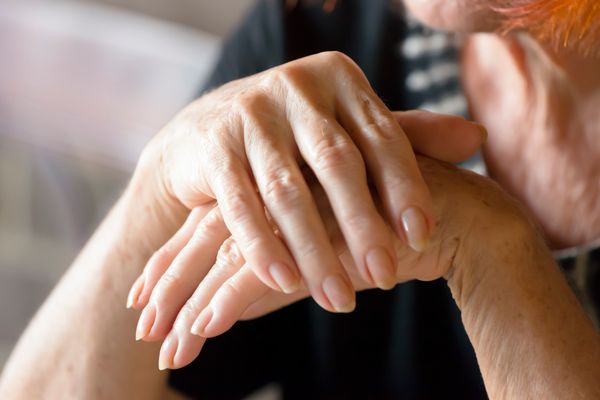This article has been archived. We will no longer be updating it. For our most up-to-date information, please visit our arthritis information here.
Imagine that completing simple everyday activities—like brushing your teeth or washing the dishes—becomes almost impossible due to the aching and swelling of your joints. If you are one of the estimated 1.5 million Americans living with rheumatoid arthritis (RA), this may be a frustrating reality.
Rheumatoid arthritis is a painful and sometimes debilitating chronic condition characterized by stiff, swollen and painful joints.
Many who live with the disease feel isolated and limited by it, so it is important to know about the options for managing and controlling flare-ups. While RA can affect anyone, the disease is two to three times more common in women than in men.
What Is Rheumatoid Arthritis?
Rheumatoid arthritis (RA) is an autoimmune disease that causes the body to attack healthy membranes surrounding the joints. The most common symptoms associated with RA are painful, swollen joints in the hands, feet, wrists and ankles, although other areas of the body can be affected.
While the exact cause of RA is unknown, certain genetic and environmental factors have been associated with it, and physicians have also tied cigarette smoking to higher incidence of the disease.
Early detection and diagnosis are keys to managing and controlling RA. If left untreated, the disease can result in permanent joint damage, bone erosion and deformity. Early diagnosis of RA can be difficult, because often symptoms are similar to those of many other diseases. Once diagnosed, it is essential to work with your doctor to find a treatment that works best for you.
Controlling RA Flare-Ups
There are a number of treatment options that aim to relieve your symptoms and some may slow the disease's progress. Everyone who has RA experiences it differently, so the first and most important step in managing the disease is to work closely with your health care team to track how RA affects your daily activities. There is no "one size fits all" approach for those who live with the disease. Talk to your health care professional about what is best for you.
In addition to finding a treatment plan that works for you, incorporating a fitness routine into your daily activities can help manage symptoms and get RA under control. Remember to consult with your physician prior to starting any exercise regimen.
It may seem that physical activity should be kept to a minimum to avoid flare-ups, but studies show that a combination of medication and regular physical activities can sometimes help to relieve pain and reduce inflammation caused by the disease, as well as improve function in daily activities. However, during acute flares of disease, rest and even sometimes splinting very inflamed joints can help.
Balancing Medication and Exercise
Your treatment plan will most likely include medications to relieve pain and reduce inflammation. Although there is no cure for RA, there are several types of medications used to slow the course of the disease and provide pain relief. Medications include non-biologic and biologic disease-modifying antirheumatic drugs (DMARDs), analgesics, nonsteroidal anti-inflammatories (NSAIDs) and corticosteroids.
Staying active with RA is key for your disease management. Regular exercise can help improve physical function, allowing you to do more for yourself and improve your quality of life. It's important to speak with your rheumatologist or physical therapist about when you should exercise, as well as listen to your own body.
When you are experiencing RA symptoms like intense pain and stiff and swollen joints, going to the gym is probably not on the top of your list of priorities. However, regular exercise can help to control and even reduce such symptoms because it helps keep bones, cartilage tissue and muscles around joints loose. In addition, regular exercise is associated with benefits like lowered blood pressure, reduced risk of heart disease, weight management, sleep improvement and mood elevation, to name a few. Staying active can help improve physical function, allowing those with RA to do more for themselves and improve health-related quality of life.
Customizing a fitness program to your individual needs is also important. For example, if you experience RA in the joints of your hands, you may find certain hand exercises helpful. Or if RA affects your knees, hamstring and glute stretches may be beneficial. Finding a program or activity that you enjoy will help you maintain regular workouts.
The best time to exercise is when RA pain and stiffness are low, your energy level is high and your arthritis medications are having the greatest effect. While regular physical activity may ultimately help your quality of life, be willing to take a few days off if pain is too extreme or a flare-up is especially strong. Rest is equally important to your health.
Talking About RA With Loved Ones
Living with RA and chronic inflammation can be challenging as you cope with debilitating symptoms and emotional ups and downs. Asking for support when needed can be hard for some, especially for those who want to lead independent and active lives. A common difficulty for many women living with RA is that communicating pain symptoms is subjective and highly individualized. Don't be afraid or ashamed to discuss your symptoms with loved ones. Because RA doesn't go away, your symptoms can interfere with daily life and lead to depression, anxiety, anger and low self-esteem.
Discussing RA symptoms and challenges with loved ones should only strengthen your relationship and help him or her understand what you are going through every day. It's important for your loved ones to listen to you describe your experiences and how they are unique to you, since RA affects everyone differently.
Sharing is especially helpful if your loved one comes with you to your doctor appointments; you both will be on the same page about the severity of your symptoms, what has changed since your last visit and how these developments affect your personal treatment options and management routine. For tips on managing life with RA, read our
Tips for Managing Rheumatoid Arthritis.







